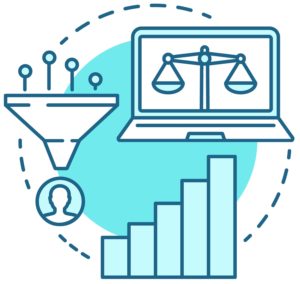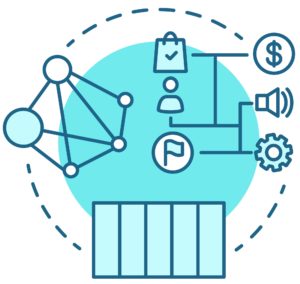
“Half of the money I spend on advertising is wasted; the trouble, I don’t know which half.”
John Wanamaker
Implementing marketing strategies is a tough task but measuring, analysing, and reporting on them is a different kettle of fish. However, it is a necessity!
Firstly, you need an understanding of effectiveness to get the most out of your technology investment, to expand on tactics that are delivering successfully and to stop those that are not. It is the insight you need to focus your efforts.
Secondly, it will help internally promote the value delivered to your organisation whether it is in terms of traffic, leads or ideally actual revenue. That proof-point is a crucial thing to have during a budget review, as otherwise “you will remain a cost-center that makes mouse pads, golfing umbrellas and does pretty advertisements” (Stephen Yeo, European Managing Director, Panasonic).
What Is Marketing Attribution, Really?
Marketing attribution is an essential component of every successful marketing strategy. Simply defined, it is how marketers assess the ROI of their channels. Leveraging this knowledge allows for the optimisation of marketing efforts, tools and technologies going forward.
Why the above is important is obvious, how it is achieved is in no way as straight forward! The challenge lies in the fact that there is no single point of interaction preceding a purchase. In fact, there are almost always multiple touchpoints, with a plethora of ways to allocate revenue to said touchpoints – and that’s even before accounting for the halo effect of influencers. Long story short; there are many variables to consider when it comes to marketing attribution!
Luckily, a number of models have evolved to help marketers face the challenges of multi-channel selling. The question is, how do these differ? And which one is the ‘right’ choice?
Which Marketing Attribution Model Is Right?
Below are a few marketing attribution models that can help understand the pros and cons of the various options at our disposal.

Single Touch attribution (first/last touch)
Definition: It is the most common model which consists of assigning all the value (whether pipeline or revenue) to the first or the last activity that occurred.
Example: One extreme version is to say that, since sales have closed all the deals, they have generated all the revenue – this is somewhat true, but not useful… At the other end of the spectrum, you could say that marketing generated 60% of the revenue because we can track the leads back to a specific event or a downloaded asset. This is much more insightful, but still not the full picture.
Benefits: This model has the merit of being straightforward to understand and implement. It can provide insight into what is driving the top of the funnel and the cost per lead metric. It can also be used to quickly project what the long-term impact of programs will be.
Downsides: The model can be overly simplistic and can potentially lead to poor decisions when one single touchpoint gets 100% of the credit. Nurturing activities are systematically undervalued whilst, in the “last touch” scenario, initial awareness and lead generation are disregarded. It’s also poorly suited to Account Based Marketing which utilises multiple touches and involves numerous people.
Overall, it is a blunt instrument that gives limited visibility on marketing ROI.

Non-Weighted multi-touch attribution
Definition: The multi-touch model recognises the fact that closing deals involves multiple people and multiple touches. It is non-weighted which means that it equally recognises the contribution of each individual touchpoint. It is sometimes called a “Peanut-butter approach” as it evenly spreads the value measured across all touches.
Benefits: The model incorporates better nurturing and the lead generation efforts, and is useful for revenue cycles with multiple touches. All touches are recognised, not just the first or the last.
Downside: This attribution method requires the implementation of multi-touch tracking which can be a technical challenge (think cookies). Additionally, credit tends to get “watered down” if there are many touchpoints. For example, if a long sales cycle has 100 touchpoints, each would just get attributed 1%. Low impact touchpoints get over-valued whilst high impact touchpoints get under-valued.
Quite simply, the main flaw of the model is that it doesn’t differentiate the degree of impact of the touches.
Weighted multi-touch attribution
Definition: To remedy the limitations stated above, the weighted model attempts to assign an accurate value to each touchpoint rather than spreading it evenly.
Benefit: The Weighted model measures the performance of efforts regardless of where they occur in the buyer journey. It is especially useful for long revenue cycles with many touches.
Downside: The model requires both sophisticated tracking and additional data modelling. Bias is introduced during the analysis because assumptions are generally required (for example, the assumption that attending an event is more impactful than downloading a whitepaper). It tends to provide better accuracy, but isn’t the easiest to start with.

Weighted model variants
There are several versions of the weighted model, each focusing on a different approach.
- The Time Decay model gives more credit to the touchpoints closest to the conversation and assumes that the closer to the conversation, the more influence it had on the deal closing. It therefore undervalues top of funnel marketing efforts as those will always be the furthest away from the lead becoming an opportunity.
- The U-shaped model focuses on lead generation. It does track every single touchpoint but instead of giving equal share to each one, the first touch gets 40%, the lead conversion touch gets 40% and the remaining touchpoints equally split the remaining 20%. As with the Time Decay, this model doesn’t consider any efforts beyond lead conversion.
- The W-shaped model is essentially the U-shaped model widened-up to include the opportunity stage. The 3 key touchpoints in the customer journey are allocated 30% each and the last 10% goes to the remaining touches.
- Finally, the full-path model goes one step further by including the closed-won stage as a fourth key touchpoint. Each of them now receives 22.5% of the credit and the last 10% is split equally amongst the remaining touchpoints.
Control Groups
Definition: The Control group approach consists in measuring and comparing two groups’ results. Typically, one of the groups is exposed to the marketing initiative whilst the other gets nothing, or a simple, generic message. Provided all other factors are equal, any difference in behaviour between the two groups can be attributed to the program being tested.
Benefits: It is a measure rather than an attribution so can provide a more accurate view on the impact of your marketing programs. It’s also a measure by design rather than an afterthought (which, in a way, all attribution models are).
Downsides: It is not suited to above the line awareness campaigns. You can only test a few things at a time so it cannot give a fully comprehensive and ongoing perspective. The approach sometimes struggles to reach mathematical significance, especially in a B2B context where volumes are low. Designing mathematically sound control groups is not trivial and experts will argue on the best way of achieving a group that is both representative and of the right size. Finally, insulating the test from “noise” can be tricky (for example additional triggered or targeted campaigns that interfere in the results).
Marketing Mix Modelling
Definition: This model uses regression modelling to show how sales volume outcomes are dependent on various independent marketing touches and other non-marketing factors. It is more typically used in a B2C context because it requires high volumes of data.
Benefits: It is the most holistic approach, measuring the impact of all programs as well as external factors. Both effectiveness and efficiency are considered which provides comparison points across channels and not just across programs within a channel.
Downsides: As mentioned above, regression modelling requires a lot of data to be accurate. It might also take a substantial investment in time and money to collect, store, prepare and analyse the data. Doing this also requires more sophisticated analytical skills than for other methodologies. Depending on how it is set up, it can be biased toward shorter-term sales results as opposed to longer-term brand building activities. Overall, it is a complex approach which is not easy to get right.
Get Started With Marketing Attribution
As technology evolves and consumers spread even further across channels and touchpoints, marketing attribution is going to become even more important in ensuring marketing teams work towards a shared goal. While there is no clear-cut ‘right’ marketing attribution model, each one is certainly more suited to a different approach. The key is ensuring that the model fits your business.
Not sure which one to use or how to implement it? Reach out and discuss how TAP can help guide you through this challenging topic.



